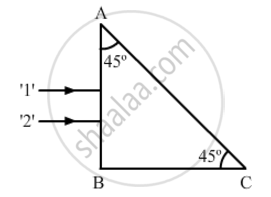Advertisements
Advertisements
प्रश्न
Using the monochromatic light of the wavelength in the experimental set-up of the diffraction pattern as well as in the interference pattern where the slit separation is 1 mm, 10 interference fringes are found to be within the central maximum of the diffraction pattern. Determine the width of the single slit, if the screen is kept at the same distance from the slit in the two cases.
उत्तर
If a is the width of the single slit, then for the central maximum of the single slit diffraction pattern,
`sin theta ≈ theta = lambda_1/"a"`
⇒ Total angular width, `2 theta = (2lambda_1)/"a"` ...(1)
For 10 interference fringes of the double-slit interference pattern to lie within the central maximum of the single slit pattern,
⇒ Total angular width, `2 theta = 10(2lambda_2)/"d"` ...(2).....(d is the separation between the slits).
From equation 1 and 2, `(2lambda_1)/"a" = (102lambda_2)/"d"`
As the light of the same wavelength is used in both cases, so λ1 = λ2
Hence,
`2/"a" = 10/"d"`
⇒ `"a" ="d"/5 = 1/5 "mm" = 0.2 "mm"`
⇒ a = 0.2 mm
APPEARS IN
संबंधित प्रश्न
Two monochromatic rays of light are incident normally on the face AB of an isosceles right-angled prism ABC. The refractive indices of the glass prism for the two rays '1' and '2' are respectively 1.35 and 1.45. Trace the path of these rays after entering the prism.

When monochromatic light travels from a rarer to a denser medium, explain the following, giving reasons:
(i) Is the frequency of reflected and refracted light same as the frequency of incident light?
(ii) Does the decrease in speed imply a reduction in the energy carried by light wave?
Which of the following sources provides the best monochromatic light?
"Monochromatic light should be used to produce pure spectrum". Comment on this statement.
Can the interference pattern be produced by two independent monochromatic sources of light? Explain.
State with reason, how the linear width of the central maximum will be affected if
(i) monochromatic yellow light is replaced with red light, and
(ii) distance between the slit and the screen is increased.
Find the angle of incidence at which a ray of monochromatic light should be incident on the first surface AB of a regular glass prism ABC so that the emergent ray grazes the adjacent surface AC. (Refractive Index of glass = 1 .56)
Assertion(A): The photoelectrons produced by a monochromatic light beam incident on a metal surface have a spread in their kinetic energies.
Reason(R): The energy of electrons emitted from inside the metal surface, is lost in collision with the other atoms in the metal.
Monochromatic light of wavelength 396 nm is incident on the surface of a metal whose work function is 1.125 eV. Calculate:
- the energy of an incident photon in eV.
- the maximum kinetic energy of photoelectrons in eV.
The Figure below shows a ray of monochromatic light LM incident on the first surface AB of a regular (equilateral) glass prism ABC. The emergent ray grazes the adjacent surface AC. Calculate the angle of incidence. (Refractive Index of glass = 1.5)

